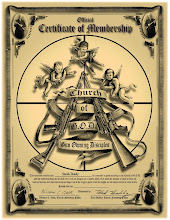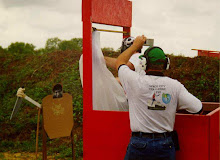Yes they are related.
Teachers from Pre-K to Post-Grad mostly rely on tests that require the student to regurgitate their lecture and reading assignments for a passing grade. That is how we are conditioned that teaching is to be done. Unfortunately that gets ingrained and we get to the point where memorization of stuff is what is stressed as knowledge. There is a problem there.
My favorite memory from College was first day of Wave Optics. Prof walked in and said,
"Some of you will enjoy this class and some of you will hate it. I am going to teach you that 2+2=4, 2X2=4 and 4-2=2. When the test comes out I will ask you what 4/2 is. I will have given you all the tools you need to find the correct answer. But, I will not have given you the exact answer in my lecture. You will have to know how to apply what I have taught you to pass."
Gunnies have heard, the 3 NRA Rules, the 4 Coopers Rules, Joe's 28 Rules and maybe Steve's 2 Rules. They often get passed on as new shooters are introduced to shooting by a known gun owner. The problem is what is passed on is, "These are the Rules. Know them." Instead of, Here are the rules, what they mean and how they apply. Look at any batch of shooters at a public range. Chances are they have been told the rules before at some point in their life and the rules are probably posted somewhere at the range as well. Do they understand the rules and know how to apply them at the range and in everyday life? After watching them for a few minutes you will get the idea that maybe they do not really understand the rules. Never mind that half of them are not wearing any eye protection. Or even the stores range officer who is standing directly under the sign that says, "Eye and ear protection must be worn by everyone on the range."
One of the biggest problems we see with shooters showing up at our classes that have marked for their experience, "Long time gun owner and shooter but no formal training" is that they can recite the rules but have little understanding of what they really mean and how they apply.
The difference between an shooter and a person who owns a gun is how the act the 98% of the time they are not shooting.
Think about that for a moment please. It is easy to think about what direction your firearm is pointed when you are concentrating on hitting the bulls eye of a target. Most of the time, people manage to keep their booger hook of the bang switch when they are not trying to make that perfect shot. Likewise, if you are on the firing line trying to make that shot, your gun is likely to be loaded. You are even pretty sure about the backstop that is behind the target.
The problems start when you are no longer concentrating on that perfect shot. That is when goober 1 turns to goober 2 and says, "Hey, did you see that shot?" All the while pointing the gun at them with their finger on the trigger. Or, they have finished shooting and turn top say that and if questioned reply with, "It's OK, the gun ain't loaded." Many people are negligently killed with "not loaded" firearms each year. I lost a friend to two violations. First was the stupid, it ain't loaded and the second was safe direction for a deer rifle is not the wall or someone else's head.
A person may be able to recite "Always keep the gun pointed in a safe direction" and have no idea what that means. Or, that it applies at all times. If you are attacked by a violent criminal and feel that your life or that of a loved one is in immediate danger, what is the safest direction to point your gun? If you are at the mall and there is a large crowd of people and an active shooter about, do you point your gun out into the crowd? Is that a safe direction? Inside an apartment, is the living room wall a safe direction? There is nothing between you and the wall so it must be safe right? Is the floor a safe direction? Is it concrete under the cheap smelly carpet? How about up? Think the upstairs neighbors would mind?
Finger off the trigger?!?!?! That is THE biggest habit we have to break with many newly trained shooters. Not the fresh new shooter who has come to the range for the first time to get professional training. They usually are so intent on learning everything they can and applying it, they pay close attention to safety while out on the range for the first time. Problem is the long time shooter with no formal training that thinks they are already safe and don't understand why we are harping on them about muzzle and finger.
How often have you seen someone eject a live round from their gun and immediately bend down to pick it up? With the gun still in their hand? Where did the muzzle go when they bent over?
How about malfunction or just reloading. How often have you seen people on the firing line turn the gun and their hand so they can get more leverage on the slide to rack it? Pointing the gun at the leg or torso of the person next to them. Even at an indoor range where there are dividers between shooting lanes. Just because you can't see the person next to you doesn't mean you can't shoot them or be shot by them. there I go with that safe direction thing again.
How about "cowboys" on the range? From ready to shooting position the muzzle points way up as they arc the gun out to full extension. Probably with their finger on the trigger. What happens if they let a round off while en-route to full extension? It's OK it's just a .22! You want to tell that to the parents of the 8 year old who was jumping on the trampoline they got for Christmas that you just killed a mile down the road? I don't.
Is that tree you have the target tacked to a safe backstop? Well, it may stop the rounds you are shooting at the target but what happens when you miss? Oh, you never miss so it is OK? What and or who is out beyond the tree? Do you even know?
What about home defense? The gunstore counter guy who tells you, "The ultimate is a shotgun loaded with birdshot. You can still use it to stop an intruder but it won't go through sheetrock into the next room." Think about that one for a moment please. IF it won't go through a sheet of sheetrock how is it supposed to penetrate into a human who is probably wearing clothes? Besides, at room distances, birdshot will most certainly go through both layers of sheetrock in a wall and still have enough energy to do damage. Been there. Shot the fake wall structures to test it. Have the shot to hell t-shirt from the mannequin on the other side.
Bottom line is this, Just being able to recite the rules isn't good enough. Not for the shooter and certainly not for the shooter that is bringing more folks into the fold. People need to understand what the rules actually mean and how to apply them all the time. Whether on the range, at the house or out in public.
Dan Crenshaw Threatens To Sue Shawn Ryan
1 hour ago





Excellent post. Lots of points to ponder. I rant frequently to family and friends about the state of education in this nation. I personally think that the biggest casualty has been the ability to think critically and apply knowledge in a thoughtful manner instead of merely regurgitating information. Never is that more true than when dealing with firearms and other weapons.
ReplyDelete